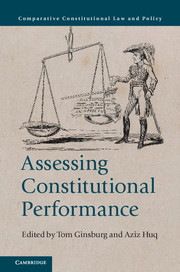Book contents
- Frontmatter
- Contents
- List of figures
- List of tables
- List of contributors
- Acknowledgments
- INTRODUCTION
- PART I DEFINING CONSTITUTIONAL PERFORMANCE
- PART II MANAGING SPECIFIC CONSTITUTIONAL CHALLENGES
- PART III CASE STUDIES
- 11 Ambedkar's constitution: Promoting inclusion, opposing majority tyranny
- 12 Assessing the Constitution of Kenya 2010 five years later
- 13 The Arab Spring constitutions: For whose benefit?
- 14 Stability in flexibility: A British lens on constitutional success
- Index
- References
14 - Stability in flexibility: A British lens on constitutional success
from PART III - CASE STUDIES
Published online by Cambridge University Press: 05 August 2016
- Frontmatter
- Contents
- List of figures
- List of tables
- List of contributors
- Acknowledgments
- INTRODUCTION
- PART I DEFINING CONSTITUTIONAL PERFORMANCE
- PART II MANAGING SPECIFIC CONSTITUTIONAL CHALLENGES
- PART III CASE STUDIES
- 11 Ambedkar's constitution: Promoting inclusion, opposing majority tyranny
- 12 Assessing the Constitution of Kenya 2010 five years later
- 13 The Arab Spring constitutions: For whose benefit?
- 14 Stability in flexibility: A British lens on constitutional success
- Index
- References
Summary
INTRODUCTION
On many of the external metrics outlined in the Introduction to this volume, the United Kingdom ranks among the most successful nation states: It is a functioning democracy with robust rights protection; its public sector is one of the least corrupt; and its citizens benefit from an array of public goods, including health care, education, and a variety of other social welfare programs. From an internal perspective, the flexible British constitution appears well matched to the wants of its citizenry – as J.A.G. Griffith wrote more than thirty-five years ago, “the constitution is no more and no less than what happens. Everything that happens is constitutional. And if nothing happened that would be constitutional also” (Griffith 1979: 19). In short, there is no obvious gap between the aspirational and the actual.
This exceptional performance suggests we should look to the United Kingdom as a model for constitutional design. But, of course, the British constitution sits uneasily in contemporary constitutional studies. As an uncodified set of written laws and political practices with ancient roots (e.g., Magna Carta 2015) and modern fruit (e.g., The Fixed-Term Parliaments Act 2011), the constitution is difficult to pin down with precision and certainty. Even senior judges and politicians struggle: Lord Scarman described the constitution as “hidden, and difficult to find” (1993: 319), and Lord Callaghan suggested it has a certain “back of an envelope” quality to it (Hennessy 1995: 6). Academics agree that the specific substantive elements that make up the constitution are subject to debate (Hennessy 2007: 346) as well as that different understandings of the constitution – in Scotland and England, in particular – have coexisted for centuries (Feldman 2005: 347).
Yet, even if it were possible to extrapolate a modern model from this historically contingent and idiosyncratic system, an antecedent question niggles: How confident should we be in this positive assessment of the United Kingdom's constitutional success? A closer look at life in the British state uncovers roiling constitutional politics. Complaints abound of constitutional uncertainty, constitutional malaise, constitutional anomie – even constitutional crisis (Bogdanor 2015; Webber 2014). This discourse reveals a higher level of dissatisfaction than might be expected in a country that otherwise seems a paragon of constitutional success.
- Type
- Chapter
- Information
- Assessing Constitutional Performance , pp. 393 - 420Publisher: Cambridge University PressPrint publication year: 2016

